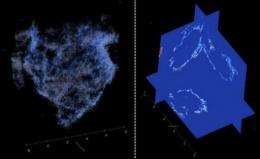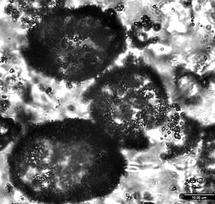Earth's oldest fossils boost hopes for life on Mars

(PhysOrg.com) -- Microfossils found in Australia show that more than 3.4 billion years ago, bacteria thrived on an Earth that had no oxygen, a finding that boosts hopes life has existed on Mars, a study published Sunday says.
The Earth’s oldest fossils have been found in Australia by a team from the University of Western Australia and Oxford University. The microscopic fossils show convincing evidence for cells and bacteria living in an oxygen-free world over 3.4 billion years ago.
The team, led by Dr David Wacey of the University of Western Australia and including Professor Martin Brasier of Oxford University, report the finding in the journal Nature Geoscience.
‘At last we have good solid evidence for life over 3.4 billion years ago. It confirms there were bacteria at this time, living without oxygen,’ says Professor Brasier of the Department of Earth Sciences at Oxford.
The Earth was still a hot, violent place at this time, with volcanic activity dominating the early Earth. The sky was cloudy and grey, keeping the heat in despite the sun being weaker than today. The water temperature of the oceans was much higher at 40-50 degrees – the temperature of a hot bath – and circulating currents were very strong. Any land masses were small, or about the size of Caribbean islands, and the tidal range was huge.
Significantly, there was very little oxygen present as there were no plants or algae yet to photosynthesise and produce oxygen. The new evidence points to early life being sulphur-based, living off and metabolising compounds containing sulphur rather than oxygen for energy and growth.
‘Such bacteria are still common today. Sulphur bacteria are found in smelly ditches, soil, hot springs, hydrothermal vents – anywhere where there’s little free oxygen and they can live off organic matter,’ explains Professor Brasier.

The microfossils were found in a remote part of Western Australia called Strelley Pool. They are very well preserved between the quartz sand grains of the oldest beach or shoreline known on Earth, in some of the oldest sedimentary rocks that can be found anywhere.
‘We can be very sure about the age as the rocks were formed between two volcanic successions that narrow the possible age down to a few tens of millions of years,’ says Professor Brasier. ‘That’s very accurate indeed when the rocks are 3.4 billion years old.’
The microfossils satisfy three crucial tests that the forms seen in the rocks are biological and have not occurred through some mineralisation process.
The fossils are very clearly preserved showing precise cell-like structures all of a similar size. They look like well known but much newer microfossils from 2 billion years ago, and are not odd or strained in shape.
The fossils suggest biological-like behaviour. The cells are clustered in groups, are only present in appropriate habitats and are found attached to sand grains.
And crucially, they show biological metabolisms. The chemical make-up of the tiny fossilised structures is right, and crystals of pyrite (fool’s gold) associated with the microfossils are very likely to be by-products of the sulphur metabolism of these ancient cells and bacteria.
Early fossils of life on Earth has been a controversial area. In the past decade, the barriers that need to be overcome before claiming such evidence have been raised significantly, aided by new techniques for mapping the chemistry of rocks at fine scales.
In 2002, the same Oxford group suggested well-known microfossils from the Apex chert in Australia were not the preserved forms of ancient bacteria after all. They argued that the context, shape and mineralogy of the forms were all wrong for them to be of biological origin.
They believe the current fossils, found just 20 miles away, satisfy all criteria for judging such finds.
The researchers are now using the techniques and approaches they used in this study to re-examine other fossil finds that have been proposed to contain evidence for life on Earth at these extremely early times.
‘We’re now making detailed comparisons with all other early microfossils, and we’re very optimistic for future finds,’ says Professor Brasier.
The work also has implications for looking for life on other planets, giving an indication of what evidence for such life might look like.
Should there be life elsewhere in our solar system – on Mars or on the moons of Titan or Europa – it is likely to be similar sorts of bacteria and cells living in similar environments. So any fossils in rocks from these planets and moons ought to look like these Australian microfossils and pass the same evidence tests.
‘Could these sorts of things exist on Mars? It’s just about conceivable,’ says Professor Brasier. ‘But it would need these approaches – mapping the chemistry of any microfossils in fine detail and convincing three-dimensional images – to support any evidence for life on Mars.’
Provided by University of Oxford

















